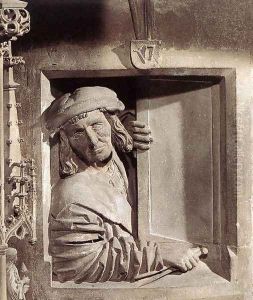Anton Pilgram Paintings
Anton Pilgram was a notable figure in the late Gothic period of art, particularly renowned for his work as an architect, sculptor, and woodcarver. Born around 1450, Pilgram's life and career were primarily anchored in the cultural and artistic milieu of Central Europe, a region that was a vibrant hub for the flourishing of Gothic art and architecture. His exact place of birth remains uncertain, but he is most famously associated with the city of Brno in today's Czech Republic, and with Vienna, Austria, where much of his known work is located. Pilgram's contributions to the art world are characterized by his mastery in merging structural ingenuity with intricate decorative elements, a hallmark of the Gothic style that was prevalent during his time.
Throughout his career, Anton Pilgram demonstrated a profound understanding of both the technical and aesthetic aspects of construction, which allowed him to excel in a variety of projects. One of his most celebrated works is the pulpit of St. Stephen's Cathedral in Vienna, a masterpiece of stone craftsmanship that showcases his skill in sculpting and his innovative approach to architectural design. This pulpit is particularly famous for the self-portrait of Pilgram, a small figure peering out from a window, which serves as a testament to his presence and personal stamp on his work.
Pilgram's influence extended beyond individual projects to the broader development of Gothic architecture in the region. He was involved in the construction and design of several significant buildings, including his contributions to the Brno Cathedral of St. Peter and Paul. His work reflects the transition from the late Gothic style towards the Renaissance, marking him as a pivotal figure in the evolution of European art and architecture.
Despite his notable contributions, many details of Pilgram's life remain shrouded in mystery, including the exact circumstances of his death in 1515. However, his legacy endures through his surviving works, which continue to be studied and admired for their beauty and technical brilliance. Anton Pilgram remains a significant figure in the history of art, whose work provides insight into the transitionary period between the Gothic and Renaissance styles and reflects the rich cultural heritage of Central Europe during the late Middle Ages.
